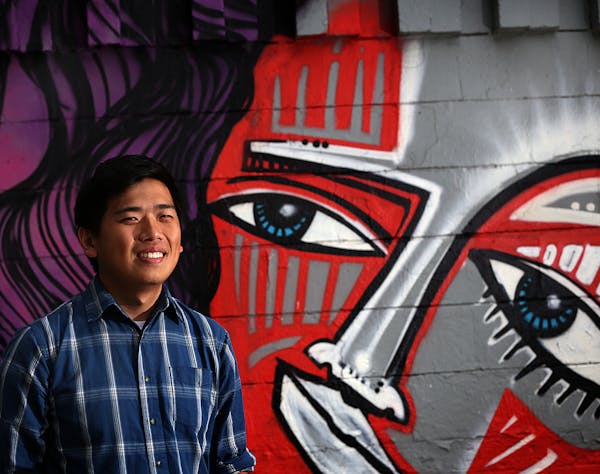The refugee camp that sprung up in Minnesota last weekend was much like others in conflicts across the globe. Exhausted refugees cried out for food. Camp doctors struggled to aid the sick. Soldiers toting M16s tried to keep peace.
But this camp had one big difference. The roughly 170 people in its drama were volunteer actors in an elaborate "humanitarian crisis simulation" that sprawled across woods and fields at a Boy Scout camp near Cannon Falls, Minn. It is a weekend class offered by the University of Minnesota, with help from a half-dozen nonprofit organizations and the Minnesota National Guard — whose soldiers act as not-so-friendly foreign government troops.
One of a handful of such hands-on training camps in the nation, it is designed to give individuals considering humanitarian aid work a realistic look at the complexities ahead. Given the migrant and refugee crisis exploding in Europe, it is timely instruction.
"The number of humanitarian disasters and the number of people needing aid has gone up astronomically in the past decade," said Sarah Kesler, a U Department of Medicine assistant professor and co-coordinator of the course.
At the same time, there's growing recognition of the critical role of humanitarian assistance, she said.
"There's a new drive to professionalize it," said Kesler.
The course is a step in that direction.
The number of people displaced by war — both within and outside of their countries — reached a record 59.5 million last year, according to the United Nations High Commissioner for Refugees. That compares to 37.5 million people in 2004. The war in Syria has been the single largest driver of the surge, the U.N. reports.
Minnesotans have a long history of volunteering for international aid projects, pitching in with medical care, well-digging, agricultural support and more. But those projects typically have played out in relatively stable settings, or in already established refugee camps. The purpose of the simulation was to give students a taste of an emerging humanitarian disaster.
"It's hard experience to get, until you get there," Kesler said.
Hunger and guns
The simulation required a weekend-long commitment from its participants, actors and trainees. A half-dozen camps scattered in the woods were inhabited by anguished refugees, who were visited by mock U.N. observers, rebel militias, supplies carriers and more during the course of the 48-hour training.
The U students taking the class played the roles of disaster relief workers, working in emergency response teams for different nonprofit aid groups.
On Saturday, the first group of relief workers headed to the makeshift hospital on site to gauge the medical care situation. The sound of screams and groans from the small building greeted them. Inside, the emergency physician — in real life Dr. Rahul Kashyap of the Mayo Clinic — leaned over a patient. He asked for a volunteer to hold the IV fluid bag and help with the exam, tiredly explaining, "I've been working nonstop. "
The "relief workers" next headed to a camp plagued by malnutrition. As a girl cried out for her missing parents, a woman moaned that people "were getting weaker and weaker." And "bandits have taken my husband," she said anxiously.
The group later tromped through the woods to another camp, where a woman and her two children pleaded for fresh water for drinking and washing. There's a river nearby, but people are using it as a latrine, the woman said.
As the mother talked, two soldiers came down the road with a wheelbarrow containing bags of MREs, Meals Ready to Eat, emergency meals typically used by the military. She eagerly grabbed some MREs and the soldiers trudged on.
The day would hold kidnappings, death, starvation, threats by rebel insurgents, anguish and chaos. The students took notes, and later created comprehensive plans to address the crisis. Their final project would be their recommendations.
Wenchen Wong, one of the students, got out of character for a moment as her team met with camp officials. She marveled at how real the camp seemed, and at the constant dangers facing refugees.
"This is amazing," said Wong. "Everything seems so real. I'm learning so many things."
It's also a terrific learning experience for the Minnesota National Guard, said Maj. Noelle Racette, who oversaw a contingent of young men in fatigues and fake M16 rifles.
"It's an opportunity for them to train in a real-life situation," said Racette. "They learn situational awareness, working in teams, working in a fluid environment. And it's great for students because when they go to other countries, they will run into military entities."
For actors representing global relief agencies, the simulation was a chance to share their years of experience with students. P.J Doyle, a Minneapolis volunteer for the international Red Cross, played herself, visiting camps, registering people by name and tracking down missing loved ones.
"I'm going to suggest that next year we bring in even more [Red Cross] volunteers," Doyle said.
The class, which ended Sunday, marked the fourth year that Minnesota hosted such an event, said Eric James, co-coordinator of the course. James, who previously taught a class on humanitarianism at the Humphrey School of Public Affairs, said the camp grew out of an awareness that students needed more than classroom teaching to understand disaster relief work.
Racette agreed, joking there was another advantage: "A day in the woods beats a day behind a PowerPoint presentation."
Jean Hopfensperger • 612-673-4511

Jury selected for Feeding Our Future trial after unusually long process due to publicity of massive fraud case
Man gets more than 21 years for part in fatal crash during rolling shootout in downtown Minneapolis

Former MnDOT official approved as Minneapolis public works director

